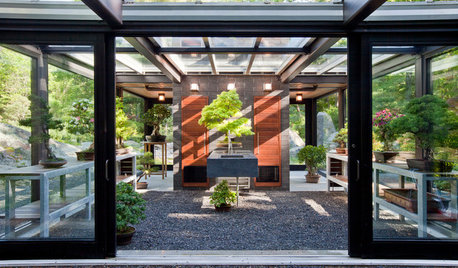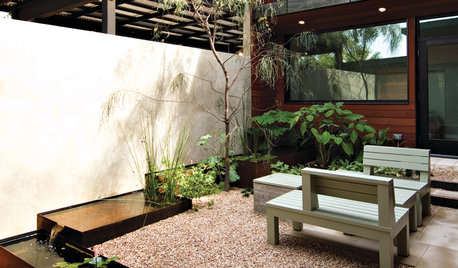How to prune these 2 unidentified Bonsais?
drursi08
16 years ago
Related Stories

TREES11 Japanese Maples for Breathtaking Color and Form
With such a wide range to choose from, there’s a beautiful Japanese maple to suit almost any setting
Full Story
GARDENING GUIDES5 Best-Behaved Trees to Grace a Patio
Big enough for shade but small enough for easy care, these amiable trees mind their manners in a modest outdoor space
Full Story
GARDENING GUIDESDesigning With Conifers: Find the Perfect Fit for Your Landscape
Conifers range from fairy-garden size to 70 feet tall. Here’s how to decifer the plant tag for the perfect long-term fit in your garden
Full Story
SPRING GARDENING7 Spectacular and Practical Spring-Flowering Trees
Put on a beauteous show in the garden with a landscape tree awash in flowers — just do your homework first
Full Story
OUTBUILDINGSModern Masters Inspire a Glass Garden House
Distilled down to structural steel and glass, this greenhouse and tearoom in Massachusetts is tops in elegance
Full Story
GARDENING GUIDES12 Japanese Maples for a Sunny Garden
The right maple in the right place shines in hot summer sun
Full Story
SIDE YARD IDEASNarrow Trees for Tight Garden Spaces
Boost interest in a side yard or another space-challenged area with the fragrance and color of these columnar trees
Full Story
LANDSCAPE DESIGNSee 5 Unexpected Ways to Use Vines
Vines can grow over slopes, trail off pergolas and add seasonal color to the garden
Full Story
FALL GARDENING7 Reasons Not to Clean Up Your Fall Garden
Before you pluck and rake, consider wildlife, the health of your plants and your own right to relax
Full Story
LANDSCAPE DESIGNStrike a Balance: Stuff vs. Space in the Garden
Zoom out to the big design picture before focusing on the little details, to create a garden with all the elements in balance
Full StoryMore Discussions








lucy
drursi08Original Author
Related Professionals
Maple Valley Landscape Architects & Landscape Designers · New Bedford Landscape Architects & Landscape Designers · Palm Springs Landscape Architects & Landscape Designers · Finneytown Landscape Architects & Landscape Designers · Brentwood Landscape Contractors · Jackson Landscape Contractors · Brunswick Landscape Contractors · Deer Park Landscape Contractors · Lynwood Landscape Contractors · Mashpee Landscape Contractors · Rockwall Landscape Contractors · Hawaiian Gardens Landscape Contractors · Highland Springs Decks, Patios & Outdoor Enclosures · Lansdale Decks, Patios & Outdoor Enclosures · West Hills Decks, Patios & Outdoor Enclosuresdrursi08Original Author
lucy
drursi08Original Author
moulman
lucy
moulman
lucy
andimia
drursi08Original Author
drursi08Original Author
lucy
andimia
drursi08Original Author
andimia